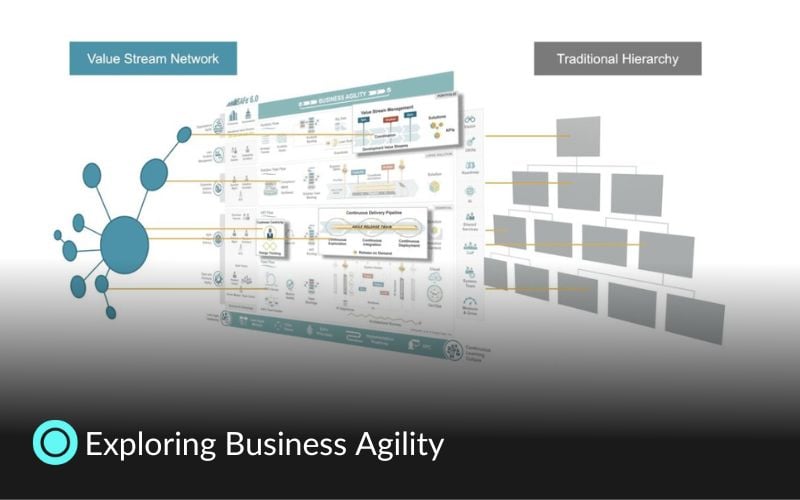In the fast-paced world of modern business, the ability to adapt and respond quickly to evolving market demands is not just advantageous; it's essential for survival and success. This is where the concept of business agility comes into play. If you want to know about unpacking what business agility truly means and why it is a critical competency in today's digital age, you are in the right place.
In this blog post, we will explore aspects of business agility in greater detail, drawing on the comprehensive insights provided by SAFe. We aim to provide a clear understanding of how businesses can cultivate agility to not only survive but thrive in the ever-changing landscape of the digital economy.
Join us as we navigate through the principles of business agility and uncover strategies to transform your organization into a more agile, resilient, and customer-focused enterprise.
What is Business Agility?
Business agility refers to an organization's ability to adapt quickly to market changes, integrate digital innovation, and consistently deliver customer value. The Scaled Agile Framework (SAFe) defines it as "the ability to compete and thrive in the digital age by quickly responding to market changes and emerging opportunities with innovative, digitally-enabled business solutions." This definition highlights the critical elements of speed, innovation, and adaptability in the digital era.
To fully grasp what is business agility, it's essential to understand its multifaceted nature. It's not just about being fast; it's about being strategically responsive. It involves a holistic approach where agility permeates every aspect of the organization - from leadership and culture to processes and technology.
Key Components of Business Agility:
-
Adaptive Leadership: Leaders must foster a culture of agility, encouraging innovation, and experimentation while providing a clear vision and strategy.
-
Customer-Centricity: Agile businesses prioritize customer needs and feedback, ensuring that products and services align continuously with market demands.
-
Operational Flexibility: Agility requires flexible processes and structures that can adapt as requirements change.
-
Technology Enablement: Leveraging technology to streamline operations, enhance communication, and facilitate rapid response to change.
-
Continuous Learning and Improvement: An agile organization is always learning, adapting, and improving based on feedback and performance metrics.
By integrating these components, businesses can achieve a state of agility that allows them to navigate the complexities and uncertainties of the digital marketplace effectively.
What Does Agility Mean in Business?
In the context of modern business, agility has taken on a broader and more profound meaning. It's no longer confined to software development or project management. Instead, it's a strategic imperative across all facets of an organization.
Why Software is Eating the World
Marc Andreessen's seminal essay, "Why Software is Eating the World", laid the groundwork for understanding the pervasive impact of technology on business.
In his influential essay, Marc Andreessen articulates a powerful vision of the modern economic landscape, where software companies are at the forefront of economic transformation. Andreessen argues that software is a revolutionary force, reshaping industries and redefining business models.
He provides compelling examples of how traditional businesses in sectors like bookselling, movie distribution, and telecommunications have been disrupted by software-driven companies like Amazon, Netflix, and Skype. This seismic shift, according to Andreessen, is not limited to a few sectors but is a global phenomenon where virtually every industry is being affected by the rise of software.
This paradigm shift underscores the essence of business agility. In a world where software-driven companies are setting new standards in every industry, the ability to adapt and respond with agility becomes crucial for all businesses, not just tech companies. Embracing software's transformative power, understanding its impact on consumer expectations, and integrating digital innovation into the core of business strategies are no longer optional but necessary for survival and success.
Andreessen’s vision aligns with the principles of business agility, emphasizing the need for organizations to be flexible, responsive, and innovative in the face of rapid technological change. It highlights that to thrive in today's economy, businesses must not only adapt to the software revolution but also become active participants in it, leveraging technology to drive efficiency, innovation, and customer value.
Project to Product
In line with this, Mik Kersten, Ph.D., and author of “Project to Product: How to Survive and Thrive in the Age of Digital Disruption with the Flow Framework” (IT Revolution Press, 2018), mentioned that "Those who master large-scale software delivery will define the economic landscape of the 21st century." This statement underscores the idea that in today's world, every company is, in some sense, a technology company.
In "Project to Product," Mik Kersten offers a transformative perspective on how businesses should approach software development and delivery in the digital age. Drawing from his extensive experience and insights, Kersten argues that the traditional project-based approach to IT is no longer sufficient in a world dominated by rapid technological advancements. Instead, he advocates for a shift to a product-centric model, where IT is seen as a continuous flow of value to the customer, rather than a series of discrete projects.
Kersten's philosophy aligns closely with the principles of business agility. By shifting from project to product, organizations can become more responsive to market changes and customer needs. This model fosters a culture of continuous innovation and improvement, crucial for businesses in a software-driven world. It encourages companies to break down silos between departments, integrate feedback loops, and focus on delivering value quickly and efficiently.
In essence, Kersten's approach in "Project to Product" is not just about software development; it's about transforming the entire business mindset to be more agile, adaptive, and aligned with the fast-paced demands of the digital economy. This shift is critical for any organization aiming to thrive in the 21st century, where mastering large-scale software delivery is key to defining the economic landscape.
SAFe expands on this, explaining that achieving business agility means "the entire organization—not just development—is engaged in continually and proactively delivering innovative business solutions faster than the competition.” This holistic approach to agility underscores its importance not just in product development but in every aspect of the business, from HR practices to marketing strategies.
The Evolution of Business Agility:
-
From Technology to Strategy: Initially focused on improving software development, agility has evolved into a core business strategy.
-
Cross-Functional Integration: Agility in business requires breaking down silos and fostering collaboration across all departments.
-
Proactive Innovation: Agile businesses don’t just react to changes; they anticipate and lead market trends through continuous innovation.
-
Customer-Centric Product Development: Moving from a project mindset to a product mindset, focusing on delivering continuous value to customers.
-
Data-Driven Decision Making: Leveraging data analytics to make informed, agile decisions.
The Importance of Business Agility
In an era where change is the only constant, the importance of business agility cannot be overstated. The dynamic nature of today's markets, driven by rapid technological advancements and shifting consumer behaviors, demands a new approach to business strategy and operations.
Adapting to Market Dynamics:
-
Rapid Response to Change: In a landscape where market conditions can shift overnight, quickly adapting is crucial. Businesses that can pivot in response to new challenges and opportunities are more likely to thrive.
-
Innovation as a Competitive Advantage: The pace of technological change means that innovation is no longer a luxury but a necessity. Agile businesses are better positioned to innovate and stay ahead of the curve.
-
Customer Expectations: Today's consumers expect more - more convenience, more speed, more personalization. Agility enables businesses to meet these evolving expectations by rapidly iterating products and services.
-
Globalization and Complexity: As businesses expand globally, they encounter diverse markets with varying needs and challenges. An agile approach allows for the flexibility to navigate these complexities effectively.
John P. Kotter, in his book "Accelerate (XLR8)," highlights the urgency of this transformation. He notes, "The world is now changing at a rate at which the basic systems, structures, and cultures built over the past century cannot keep up with the demands being placed on them.” This observation underscores the need for a fundamental shift in how businesses operate.
In "Accelerate (XLR8)," John P. Kotter presents a compelling case for a fundamental change in how organizations operate to keep pace with the rapidly changing business environment. Kotter, a renowned leadership and change expert, observes that traditional hierarchical organizational structures while providing stability, are often too slow to respond to the fast-paced changes in today's world.
Kotter proposes that organizations should retain their traditional hierarchies for managing day-to-day operations but also create a separate, parallel network that can operate more agilely and focus on seizing new opportunities and responding to emerging threats. This network is designed to be more dynamic, free-flowing, and creative, driven by a coalition of employees who are eager to drive change. They work across departments and silos, fostering a culture of collaboration, innovation, and agility.
This approach directly ties into the concept of business agility. Kotter's dual operating system enables organizations to become more adaptable, responsive, and innovative, which are key attributes of an agile business. It allows companies to quickly respond to market changes, embrace new technologies, and meet evolving customer demands, all while maintaining the stability and efficiency of their core operations.
In essence, "Accelerate (XLR8)" provides a strategic blueprint for organizations looking to thrive in a business landscape characterized by constant change and disruption. Kotter's insights underscore the necessity for businesses to adopt agile principles and practices to remain competitive and relevant in the 21st century.
SAFe's Dual Operating System:
SAFe's concept of a "Dual Operating System" addresses this need by integrating an agile, cross-functional team structure within the traditional organizational hierarchy. This approach allows for:
-
Stability and Agility: Balancing the traditional, hierarchical structure that ensures stability with a more fluid, agile network that fosters innovation and rapid response.
-
Value Stream Focus: Centering around value streams encourages a continuous flow of value to the customer, rather than intermittent project-based efforts.
-
Empowered Teams: Cross-functional teams are empowered to make decisions and respond quickly to changes, driving innovation and efficiency.
-
Organizational Alignment: Aligning the entire organization around a common vision and strategy, ensuring that all efforts contribute to the overarching goals.

Tips to Make Your Business Agile
Transforming your business into an agile organization requires more than just adopting new methodologies; it demands a cultural shift and a rethinking of traditional business practices. Here are some actionable tips:
-
Embrace Agile Principles at All Levels: Agility should permeate every level of the organization, from top management to individual teams. This involves embracing principles like systems thinking with alignment and transparency, and a focus on delivering customer value.
-
Invest in Agile Training and Tools: Your team's solid preparation, such as tecnovy's customized SAFe training, equips them with the knowledge and skills to implement agile practices effectively.
-
Foster a Culture of Continuous Improvement: Encourage a mindset where continuous learning, experimentation, and feedback are part of the daily routine. This culture supports ongoing improvement and adaptation.
-
Leverage Technology for Agility: Utilize modern technologies to automate processes, enhance communication, and provide real-time data for decision-making. This technological backbone is crucial for agility.
-
Implement Cross-Functional Teams: Break down silos by forming cross-functional teams that can work collaboratively on various aspects of a product, from inception to delivery.
-
Focus on Customer Feedback: Regularly gather and act on customer feedback to ensure that your products and services are continuously aligned with market needs and expectations.
-
Adopt a Value Stream Approach: Shift from traditional project management to a value stream approach, focusing on delivering continuous value to customers through all stages of the product lifecycle.
Are you struggling with the challenge of initiating or scaling your organization's agile transformation?
It's one thing to see positive changes at the team level, but quite another to implement these changes across the entire company. Scaling agility throughout an organization can seem daunting, and effectively utilizing frameworks like SAFe to elevate your agile transformation may present its own set of complexities. This is where tecnovy's Customized SAFe Kickstarter comes into play.
Designed specifically to address these challenges, our program offers a tailored approach to adopting SAFe principles. By focusing on your unique organizational needs and context, we provide a clear, actionable pathway to not only start but also accelerate your agile journey.
Our Customized SAFe Kickstarter is more than just a training program; it's a transformational experience that equips you with the tools, strategies, and insights needed to effectively navigate and implement SAFe in your organization. Whether you're at the beginning of your agile journey or looking to enhance your existing practices, our program is structured to support and guide you every step of the way. Discover more about how our Customized SAFe Kickstarter can be the catalyst for your agile transformation.
Conclusion
In conclusion, understanding and implementing business agility is crucial for any organization looking to succeed in today's fast-paced and ever-changing business environment. By embracing the principles of agility, investing in the right training and tools, and fostering a culture of continuous improvement, businesses can become more adaptable, innovative, and customer-focused, positioning themselves for long-term success in the digital age.
Remember, the journey to business agility is a continuous one, with each step bringing you closer to a more responsive, resilient, and competitive business. Start this journey with tecnovy's customized SAFe training, and lay the foundation for a transformative future.





